Two oilseed rape growers see success in flea beetle battle
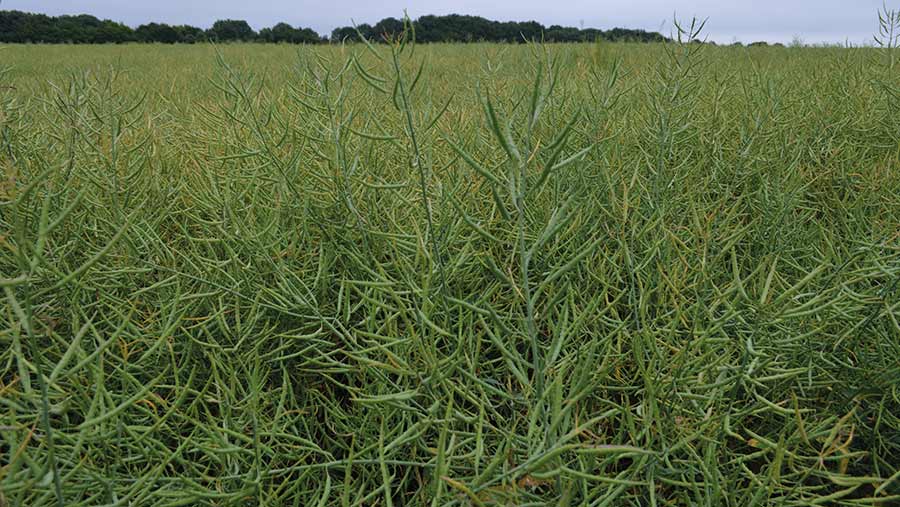 © MAG/David Jones
© MAG/David Jones More optimism is creeping into the oilseed rape world, with growers looking at direct drilling and using companion crops to cope with the twin threats of a lack of moisture at drilling and hungry flea beetles.
Direct drilling can help minimise any loss of soil moisture in a dry summer, while a variety of companion crops such as buckwheat, vetch and crimson clover are being used to deter cabbage stem flea beetles.
We visit two growers in Gloucestershire to see how a combination of these methods is seeing some early signs of success in establishing good crops of oilseed rape.
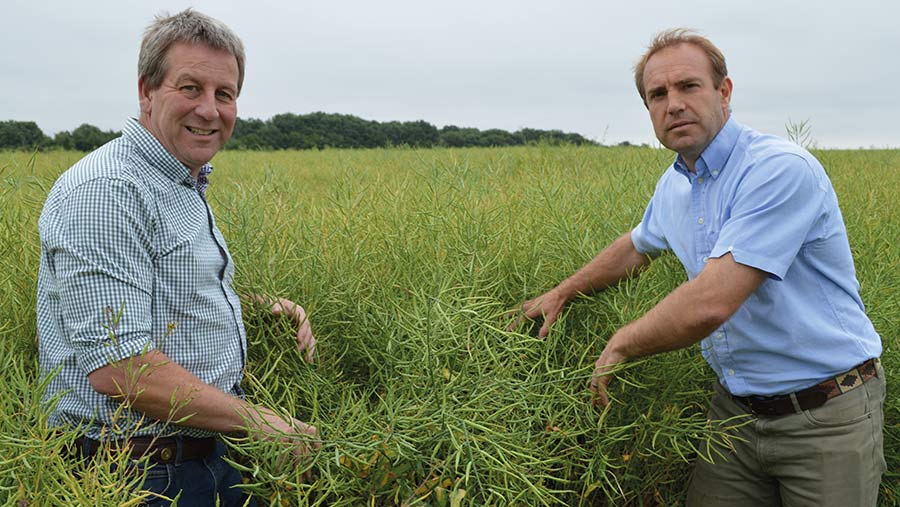
Tim Morris, left, and John Vickery © MAG/David Jones
Tim Morris
Gloucestershire grower Tim Morris is using companion crops and long wheat stubbles to hide his young oilseed rape plants from flea beetles and improve his rapeseed crop establishment.
Add in direct drilling to reduce moisture loss and a planned move to earlier drilling, and he is starting to map out an improved establishment system after the banning of a key insecticide seed treatment.
His oilseed rape crops in the lower Severn Valley show minimal damage from cabbage stem flea beetles and their larvae this season, and he is hoping for a good yield.
“We are seeing better and faster establishment by hiding the oilseed rape under a long stubble and a companion crop,” he says.
See also: Four OSR growers try different strategies to beat flea beetle
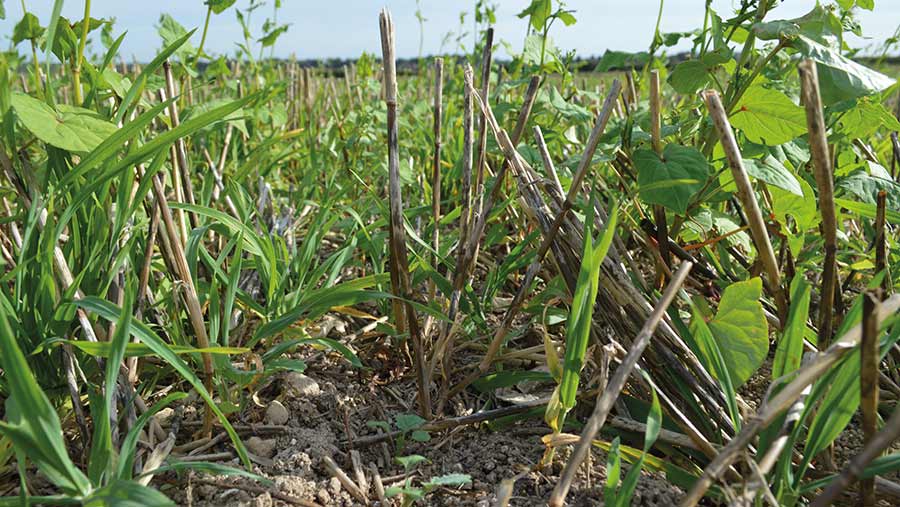
© MAG/David Jones
Seed dressing ban
Mr Morris’s crops had been established with a power-harrow and drill combination which worked well for a number of years, and average yields reached 4.5t/ha, but after neonicotinoid seed treatments were banned in December 2013, this insecticide protection from flea beetle was lost.
Yields began to suffer from flea beetle attacks on Priory Farm, Deerhurst, near Tewkesbury, with some patches of his fields showing yields down to just 1t/ha, and a new strategy was needed, which was heralded by a new drill.
He purchased a new Amazone Cayena 6m tine coulter drill capable of direct drilling, and hence was able to minimise soil disturbance and conserve valuable moisture when sowing his oilseed rape crop in the summer of 2019.
He liked the simplicity and ease of maintenance of the new drill, and tine coulters were picked as his silty soils can easily slump when using disc coulters. The drill has also allowed for the placement of fertiliser – nitrogen, phosphate and trace elements – which is applied below the seed at drilling.
Farm Facts
-
- Priory Farm, Deerhurst, Tewkesbury, Gloucestershire
- Farming 320ha of silty loams
- Growing winter wheat, oilseed rape, winter and spring beans, and linseed
Long wheat stubble
The oilseed rape crop followed winter wheat, which was left with a long stubble of about 300mm and the remaining straw chopped. The rapeseed crop was then drilled in the last week of August in a mixture with a companion crop.
Mr Morris drilled 45ha of the hybrid variety Expedient at 50 seeds/sq m to give 25-35 plants established alongside a companion crop of buckwheat, at 80-100 seeds/sq m or 8-10kg/ha, and the crop was then rolled twice.
His agronomist John Vickery explains that the tartary buckwheat variety Lifago was used as it has smaller seed and his trial work had shown it to be more vigorous than common buckwheat, while its smaller seed size allows it to mix together well with the oilseed rape in the same drill hopper.
“To get the best out of buckwheat it needs to be drilled early to have time to establish before the flea beetle migration in late August and early September,” say Mr Vickery, who works for the agronomy group Agrii.
Triple whammy
The crop faced a triple whammy of a very dry autumn, a very wet winter and then a dry spring. Despite these difficult growing conditions, Mr Morris saw much lower flea beetle damage that season, although the poor weather held yields down to 2.4t/ha.
Undeterred, he tried again as oilseed rape is a valuable break crop across the 320ha of combinable crops he grows in a four-year rotation of winter wheat, oilseed rape, winter wheat and then beans/linseed.
So in the summer of 2020, together with Mr Vickery, they tweaked the system and added in purple vetch to the companion crop, and drilled the new vigorous hybrid variety Ambassador.
While the rapidly establishing buckwheat is used for flea beetle protection which will die with the first frosts, purple vetches were introduced as a legume to provide ground cover competition to smother out blackgrass, reduce pigeon landing sites, provide roots that host valuable mycorrhizal fungi which do not colonise those of brassica species and to condition the soil surrounding the roots of the oilseed rape.
Nitrogen reduction
Furthermore, Mr Vickery says that split field trials and yield measurements conducted in 2015 showed that a well-established companion crop of vetch killed off with a herbicide in late January can allow applied nitrogen to be reduced by between 30-50kg/ha without compromising yield – a saving which generally covers the additional cost of both the buckwheat and vetch inclusion at drilling.
Unfortunately, Mr Morris’s crop was drilled in early September 2020 which was a little later than planned, due to the preceding planned winter wheat crop being replaced by a later harvested spring wheat crop, a consequence of the very wet autumn of 2019.
The oilseed rape crop did show a small amount of shot holing from flea beetles at the cotyledon early leaf stage, but it was then protected by the long stubble and the buckwheat.
“We know that certain herbicides are pretty safe to both buckwheat and vetches and that the buckwheat is controlled by low temperatures, so by late November it is generally gone and there is no requirement for additional herbicides,” says Mr Vickery.
Weed control
The herbicide regime on the farm is to use the pre-emergence product Katamaran Turbo (metazachlor, dimethenamid and quinmerac) for broadleaved and grassweed control, the graminicide Centurion Max (clethodim) if required, and then AstroKerb (propyzamide and aminopyralid) in January, which will take out the vetch.
This season, the system has worked well so far, and the two are cautiously optimistic about harvest prospects.
“The crop is looking good and hopefully we will get back to yields of around 4t/ha, and even hope for nearer 4.5t/ha,” says Mr Morris.
For next season, he has an early maturing crop of Skyfall milling winter wheat and if cut in early August then the oilseed rape could be drilled soon after the combine.
“The drill wants to be following the combine in the first half of August, and then if we get a bit of rain that would be perfect,” he says.
He is keen to persevere with a preceding crop of wheat rather than earlier maturing winter barley, as the wheat gives a stiff stubble and is easier to combine to leave a long stubble than softer-strawed barley.
“The plan is to drill in the first half of August and then for the buckwheat and vetch to overtake the young oilseed rape and confuse the flea beetle,” says Mr Morris.
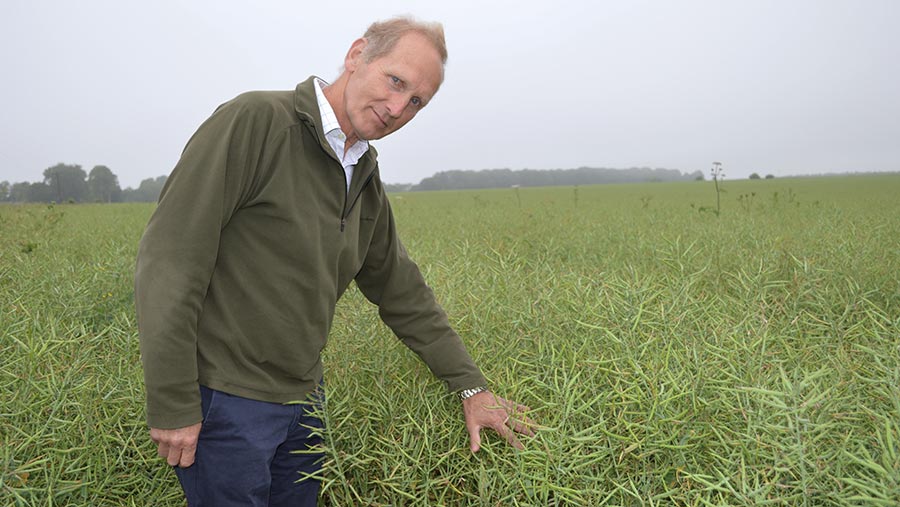
Richard Tongue © MAG/David Jones
Richard Tongue
Cotswold grower Richard Tongue was tempted back into growing oilseed rape after a three-year gap as the crop area on the Gloucestershire hills fell and he conducted encouraging trials to confuse flea beetles.
His trials with crimson clover, buckwheat and fenugreek showed the first to be the best companion crop, and he decided it would be best drilled before oilseed rape on his farm on one of the highest points on the Cotswolds at nearly 300m.
Mr Tongue was keen to bring oilseed rape back onto the farm as a key break crop on his limestone brashy soils by widening the rotation and using companion crops.
“We are now working on a more diverse cropping pattern, less reliant on agrochemicals and still managing diseases and pests,” he says.
Farm Facts
- Ray and Tongue Farms, Priory Farm, Hazleton, Cheltenham, Gloucestershire
- Farming 340ha of Cotswold brash
- Growing winter wheat, oilseed rape, spring barley, winter beans, hybrid rye and winter linseed
Three-year gap
For his last oilseed rape harvest, yields dipped to 2.5t/ha, hit by poor establishment and flea beetle damage, and after a three-year gap he admits he is now looking to relearn how to grow oilseed rape.
He started with a 16ha block of arable whole-crop silage in 2020 which was cut in the third week of July, after which the crimson clover was sown using an Opico seeder on a Carrier cultivator, planted at 7kg/ha on 23 July with the ground then immediately rolled.
He chose crimson clover as his main companion crop as it has a vigorous, leafy growth habit even on his thin brashy soils and is relatively easy to take out with AstroKerb herbicide, and as a legume it can fix its own nitrogen so it does not compete with the rapeseed.
On 6 August, the conventional oilseed rape variety Flamingo was direct drilled by lifting out the system discs of the Vaderstad Rapid at 70 seeds/sq m, along with buckwheat at 6kg/ha and a compound nitrogen-phosphate-potash fertiliser placed in the seedbed.
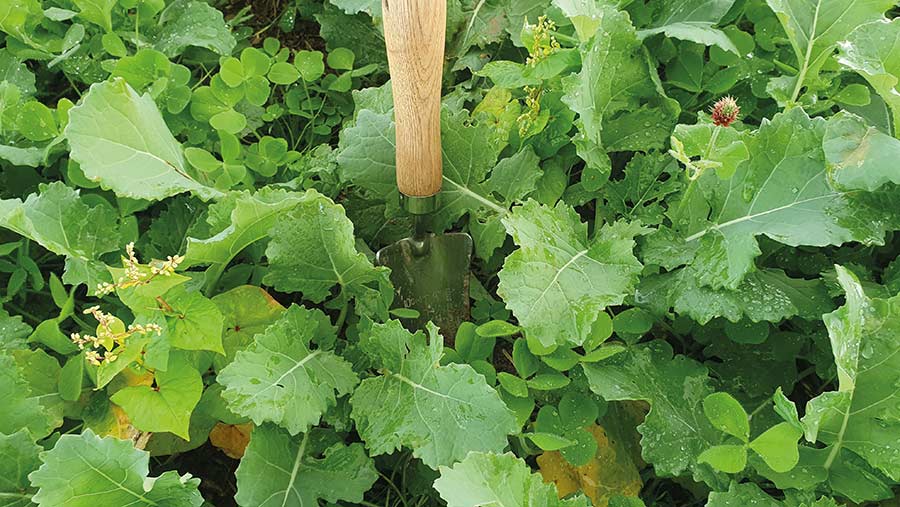
© Richard tongue
Early drilling
Mr Tongue believes that drilling the clover early is important to get it growing strongly on his 340ha of brashy soils. He also farms, like Mr Morris, at Priory Farm but this one is at Hazleton, nearly 10 miles east of Cheltenham.
“It is important to get the clover growing early to get the ground covered to hopefully confuse the flea beetles,” he adds.
John Vickery says the crop came up well and with some rain in the second half of August got off to a good start with very little adult flea beetle or subsequent larval damage seen.
“It looks a very reasonable crop and we would be delighted if it yields 3.5t/ha, anything above that would be a fantastic result,” he says.
Benefits of a legume
Mr Tongue sees advantages using a leguminous companion crop as it fixes nitrogen, picks up nutrients from the soil and improves rooting, and he has seen very little flea beetle or larval damage to his oilseed rape with its inclusion in the crop mix.
He is looking to limit spending on herbicides with no pre-emergence applied, Centurion Max used as a graminicide, Crawler (carbetamide) when needed, and then AstroKerb to keep on top of blackgrass and remove the clover, although additional cleaver control will need to be considered.
For next season, he is optimistic and plans an expanded oilseed rape area of 30ha planted after an early harvested crop of winter linseed and also a grass and clover mix that has been planted with a following crop of oilseed rape in mind.
“The direct drilling helps to conserve moisture while the companion crops help to fix nitrogen and pick up soil nutrients,” he concludes.
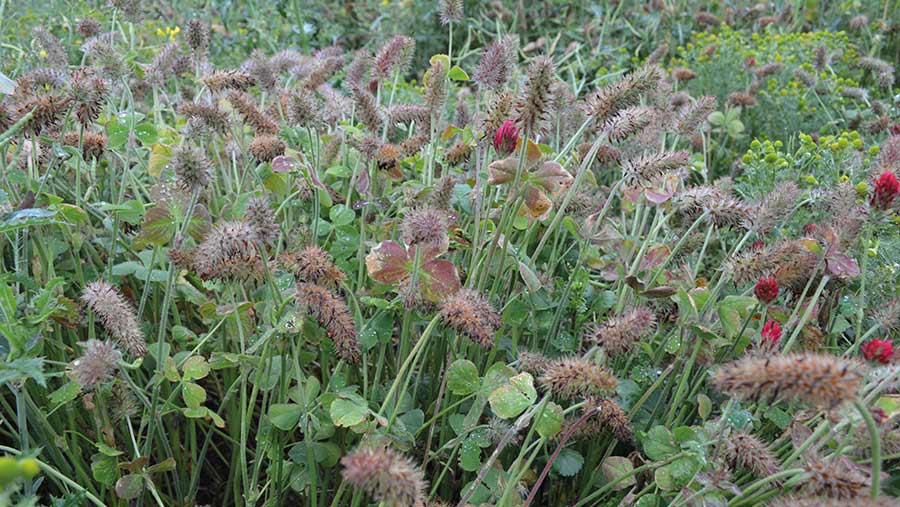
© MAG/David Jones

